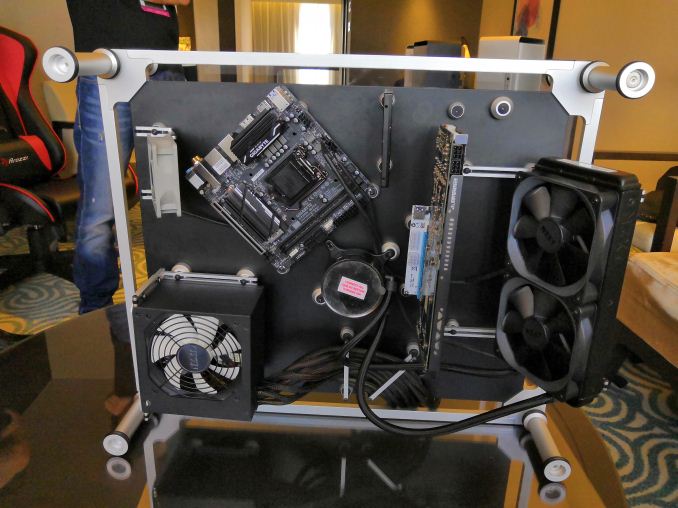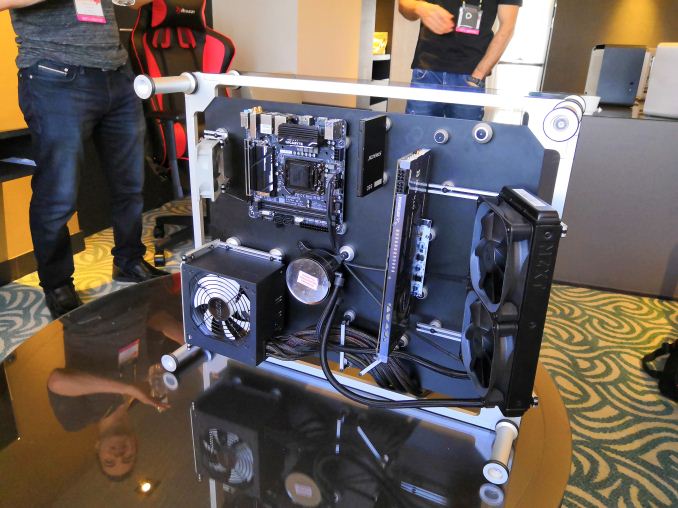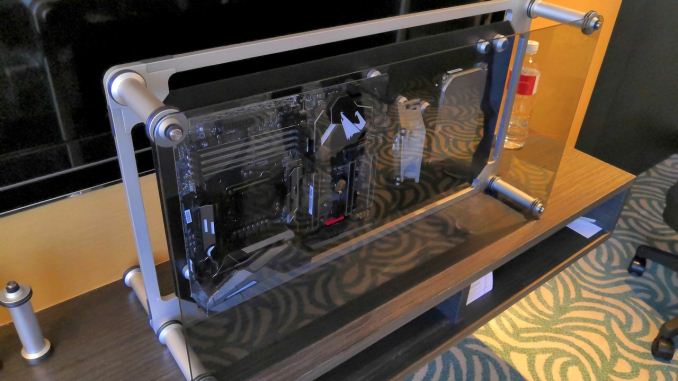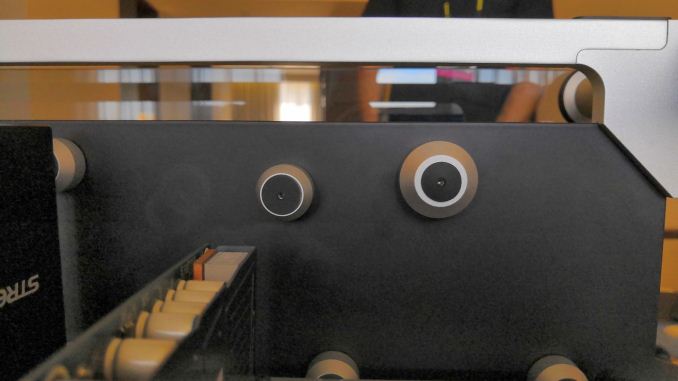Magnets, How Do They Work? A Maverick / Streacom Prototype
by Ian Cutress on June 14, 2018 9:30 AM EST
If channeling Insane Clown Posse in the title was not enough, how about a fully configurable chassis where the user can move everything to every location inside the chassis as they please? This is the principle behind a new prototype chassis designed by a company called Maverick, with Streacom serving as a manufacturing partner.
The two prototypes on display differed only in height and length, but work on the same principle: a magnetic backplane held vertically by a frame, and magnets designed to hold lots of weight attached at whatever point is necessary. This allows a system builder to enact whatever configuration needed, and adjust for airflow or aesthetics. Any computer component can be held in place by these magnets, including power supplies, graphics cards, and the heaviest SSDs.
The frame as shown is still a WIP, with Maverick trying to get feedback from journalists at the show. The magnetic backplane can be any size as required, and the magnets can be used on both sides. A potential future case could be mini-ITX sized but with multiple layers of magnetic boards, allowing for a stacked system, or even completely stacked machines for a dense implementation akin to a rack.
Obviously the main worry is if the magnets fail at any point. We were told that the ones currently in use were Neodymium, and were typically good for a minimum of 5 years, although the magnets can regain their strength/alignment with a simple tool.
As always with prototypes like this, release and availability is TBD. Maverick are looking for feedback though.
| Want to keep up to date with all of our Computex 2018 Coverage? | ||||||
 Laptops |
 Hardware |
 Chips |
||||
| Follow AnandTech's breaking news here! | ||||||













17 Comments
View All Comments
29a - Friday, June 15, 2018 - link
I wonder how much more susceptible a newer hard drive would be with data being packed so much denser.CaedenV - Friday, June 15, 2018 - link
it would be less susceptible. HDDs work based on the voltage change between bits. The smaller the bits are, the more accurate the read/write head has to be to affect a small enough area. A big dumb magnet is going to affect a large area, and change the bias away from 0v; but it is still going to have the same voltage change between individual bits. Sure, if you pull it far enough away from a baseline bias it will cause issues... but you would need one heck of a strong magnet to do thatMajGenRelativity - Thursday, June 14, 2018 - link
I've heard flash memory can have problems with extremely strong magnetic fields (I'm infinitely close to 100% certain this table isn't strong enough), but I'm more concerned about HDDsCaedenV - Friday, June 15, 2018 - link
flash memory is electronic and stationary, so it will not be easily affected by magnets. HDDs though... it would probably work 'better than you would expect'... but probably not a good long-term idea lol. That said, to kill a HDD you need a change in magnitism to really do something. A stationary magnet near a HDD isn't a super-big deal, but moving towards and away from a magnetic field over and over again... that can slowly wipe a drive.I use to work at a nonprofit PC refurbisher/recycler and we had a huge degausser. One of the fun demos that I would do to explain the difference to my volunteers was to take a working HDD out of a system, and put it through, and then plug it back in and have it be all messed up (it was actuially strong enough to induce a current strong enough to burn out the read/write head sometimes). Then I would take my cell phone and put it through with absolutely no effect.
HDDs are electro-magnetic storage, SSDs are electronic storage. Very large difference between the two.
edzieba - Thursday, June 14, 2018 - link
Not much good for an ITX system, a big series of stacked solid sheets would block far too much airflow. Existing rail-based solutions work well enough if you really need to shift things around.29a - Friday, June 15, 2018 - link
This seems like a really bad idea. I can see someone sticking a spinning drive on one of these no matter how many warnings you give them and screws last way longer than 5 years.jordanclock - Tuesday, June 19, 2018 - link
Why would there be warnings about spinning drives? And sure, screws last longer, but I'm willing to bet the kind of person that gets a case like this isn't going to mind swapping out some of the magnets every few years. It's less maintenance than replacing the water in a loop and there are a lot of custom water loops out there.